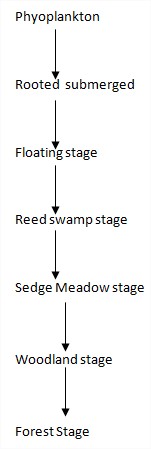11th And 12th > Biology
ECOSYSTEM MCQs
:
B
Pyramid of energy is graphic representation of energy in various trophic levels. The pyramid of energy is always upright, because energy is lost from one trophic level to another, therefore energy decreases from the base to the apex of an energy pyramid.
:
D
In a given ecosystem, various food chains are linked together and intersect each other to form a complex network called food web. Kite is a carnivorous bird, it feeds on fishes, rabbits, snakes, rats and so on. In a food web, it occupies a specific position because it feeds on lower carnivores and herbivores also.
:
D
A number of processes are involved in decomposition. They are grouped into three categories, i.e., fragmentation of detritus, leaching and catabolism. Decomposition leads to the formation of two products, humus and inorganic nutrients (minerals). Processes involved in their formation are called humification and mineralisation respectively. Thus all these steps i.e fragmentation, leaching, catabolism, humification and mineralisation are important for the complete decomposition of detritus into simpler compounds and inorganic substances.
:
A
In aquatic ecosystems like lakes and large ponds organisms are organised in a recognizable structure or pattern in two or three stratas or zones:
1. A littoral zone which has rooted vegetation
2. A limnetic zone of open water containing floating plankton
3. A deep water profundal zone where we find leeches, crabs, some annelid worms and some insect larvae too.
:
A
The total measure of the energy stored in the producers after meeting the cost of respiration is called as the net primary productivity (NPP). NPP is the biomass or energy avaiable for the heterotrophs in an ecosystem. In terms of NPP per unit area the most productive ecosystems in the world are estuaries, swamps and marshes, followed by the tropical rain forests, coral reefs, temperate deciduous forests and grasslands. The tundras, open oceans and deserts are the least productive. In coral reef, an underwater ecosystem has the highest number of producers (zooxanthallae algae in symbiosis with coral reefs).
:
D
A natural ecosystem is an ecosystem that occurs as it would without the influence of human beings. For example terrestrial ecosystems like: forests, grasslands and deserts and aquatic ecosystems like: pond, lake ,estuary, ocean etc. Prairie is a large, mostly flat area of land in North America that has few trees and is covered in grasses. Agricultural farmlands on the other hand are man-made or artificial ecosystems.
:
B
In pond ecosystem, fishes occupy more than one trophic level. In the food chain of pond ecosystems phytoplantons are the producers upon which primary consumers like zooplanktons and fishes feed directly. However, the fishes may also act as a secondary consumer in other trophic levels by feeding on zooplanktons or other small fishes.
:
C
Temperature is a major factor that can affect the rate of decomposition. Decomposers are very active in soils having a temperature of more than 25 °C, with good moisture and aeration. Similar conditions prevail in the soil of tropical regions which marks the presence of a thick humus layer in these forests. However, under comparatively low temperatures, rate of decomposition is quite slow even if you have good moisture and aeration, indicating that temperature plays the determining role here.
Decomposition is also an oxygen dependent process. In the presence of oxygen, complex carbon compounds are oxidized to produce carbon dioxide. In this sense, decomposition is essentially equivalent to respiration. If oxygen is absent or in scarce supply, specialized bacteria decompose organic matter anaerobically. Anaerobic decomposition involves more chemical steps and is slower than aerobic. Thus presence of oxygen or aerobic conditions is also a major factor affecting decomposition.
:
B
The gradual and fairly predictable change in the species composition of a given area is called ecological succession. These changes lead finally to a community that is in near equilibrium with the environment and that is called a climax community. In both primary and secondary sucession the stable community is forest where trees are the most dominat species.


















